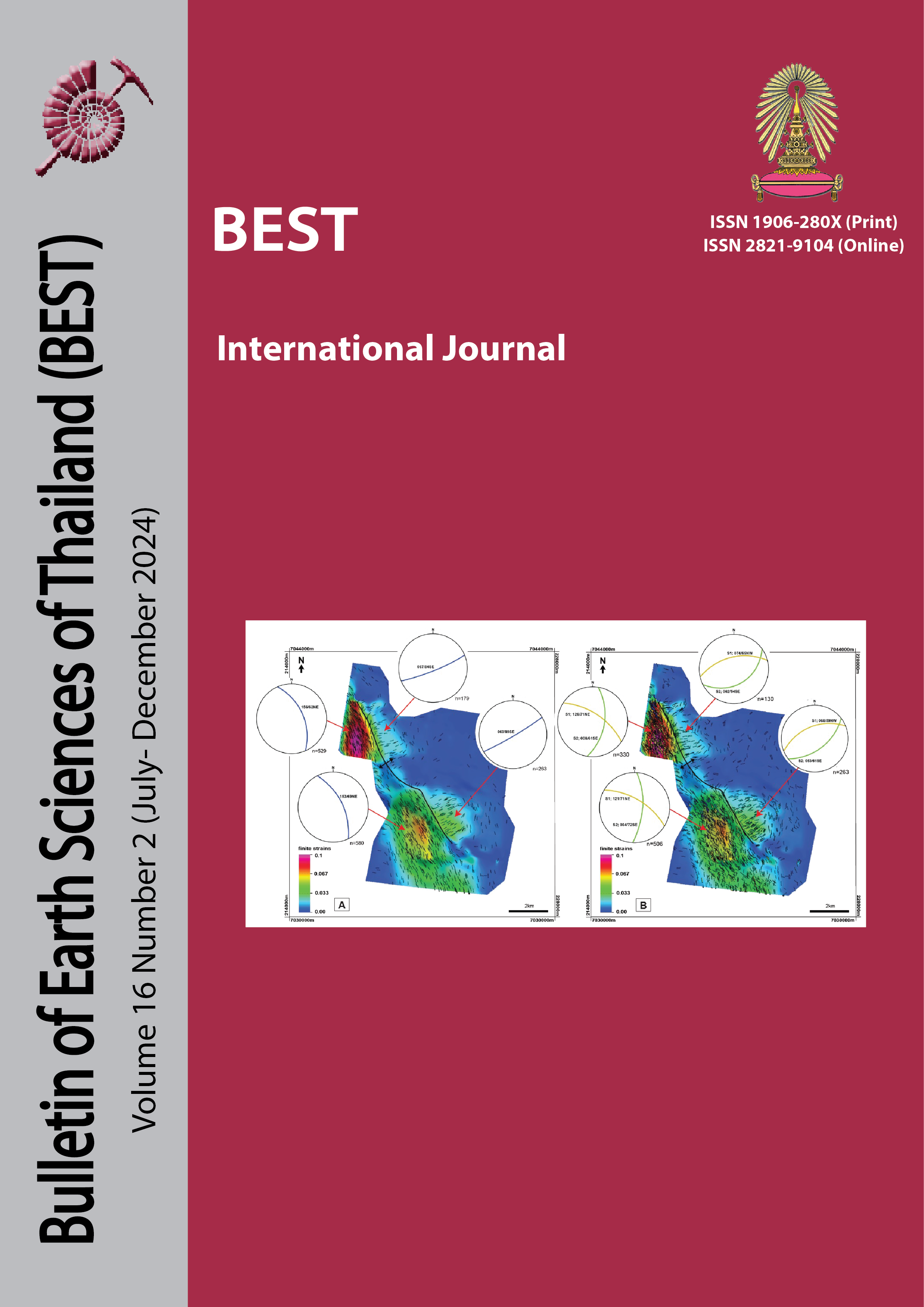Investigation of Morphotectonics along the Mae Chan and Nam Ma Fault Zones, Thailand-Laos-Myanmar Borders
Main Article Content
Abstract
The Mae Chan and Nam Ma faults are well-known as active faults which were in mainland Southeast Asia including the borders of Thailand, Laos, and Myanmar country. In this study, the morphotectonic analysis used various geomorphic indices to evaluate relative tectonic activity in the study area. A digital elevation model from the Advanced Spaceborne Thermal Emission Radiometer (ASTER) was chosen to create the watershed delineation with an analysis of the geological data and hydrogeological model. The total of hydrogeological basins is 38 basins. The six geomorphic indices to use in this study are mountain front sinuosity (SMF), valley floor width to height ratio (VF), stream length gradient index (SL), basin shape index (BS), basin asymmetry index (AF), and basin hypsometric index (HI). The analysis found that lineament patterns of the Mae Chan and Nam Ma fault mainly trend in the NE-SW direction. The result of the calculated geomorphic index reveals the low values of SMF index between 1.05-4.84, the low values of VF index from 0.42 to 25.36, the high values of SL index, a wide range of values of BS index between 1.00-3.60, AF index between 13.15 to 88.01 and the low values of HI index between 0.11 to 0.40 to facilitate with the active tectonic landforms in the study area.
Article Details

This work is licensed under a Creative Commons Attribution-NonCommercial-NoDerivatives 4.0 International License.
Copyright © 2008 Department of Geology, Faculty of Science, Chulalongkorn University. Parts of an article can be photocopied or reproduced without prior written permission from the author(s), but due acknowledgments should be stated or cited accordingly.
References
Ahmad, S., Bhat, M. I., Madden, C., & Bali, B. S. (2014). Geomorphic analysis reveals active tectonic deformation on the eastern flank of the Pir Panjal Range, Kashmir Valley, India. Arabian Journal of Geosciences, 7(6), Article 6.
Bishop, M. P., Shroder, J. F., & Colby, J. D. (2003). Remote sensing and geomorphometry for studying relief production in high mountains. Geomorphology, 55(1–4), 345–361.
Bull, W. B. (2011). Tectonically active landscapes. John Wiley & Sons.
Bull, W. B., & McFadden, L. D. (1977). Tectonic Geomorphology North and South of the Garlock Fault, California. In Geomorphology in Arid Regions. Routledge.
Burbank, D. W., & Anderson, R. S. (2011). Tectonic geomorphology. John Wiley & Sons.
Clark, M. K., Schoenbohm, L. M., Royden, L. H., Whipple, K. X., Burchfiel, B. C., Zhang, X., Tang, W., Wang, E., & Chen, L. (2004). Surface uplift, tectonics, and erosion of eastern Tibet from large-scale drainage patterns. Tectonics, 23(1).
Dubey, R. K., Dar, J. A., & Kothyari, G. C. (2017). Evaluation of relative tectonic perturbations of the Kashmir Basin, Northwest Himalaya, India: An integrated morphological approach. Journal of Asian Earth Sciences, 148, 153–172.
El Hamdouni, R., Irigaray, C., Fernández, T., Chacón, J., & Keller, E. A. (2008). Assessment of relative active tectonics, southwest border of the Sierra Nevada (southern Spain). Geomorphology, 96(1), 150–173.
Farhan, Y., Elgaziri, A., Elmaji, I., & Ali, I. (2016). Hypsometric Analysis of Wadi Mujib-Wala Watershed (Southern Jordan) Using Remote Sensing and GIS Techniques. International Journal of Geosciences, 07(02), Article 02.
Hack, J. T. (1973). Stream-profile analysis and stream-gradient index. Journal of Research of the U.S. Geological Survey, 1(4), 421–429.
Howard, A. D. (1967). Drainage analysis in geologic interpretation: A summation. AAPG Bulletin, 51(11), 2246–2259.
Jackson, J., van Dissen, R., & Berryman, K. (1998). Tilting of active folds and faults in the Manawatu region, New Zealand: Evidence from surface drainage patterns. New Zealand Journal of Geology and Geophysics, 41(4), 377–385.
Keller, E. A., & Pinter, N. (1996). Active tectonics (Vol. 338). Prentice Hall Upper Saddle River, NJ.
Keller, E. A., & Pinter, N. (2002). Active Tectonics: Earthquakes, Uplift, and Landscape. Prentice Hall.
Morley, C. K. (2004). Nested strike-slip duplexes, and other evidence for Late Cretaceous–Palaeogene transpressional tectonics before and during India–Eurasia collision, in Thailand, Myanmar and Malaysia. Journal of the Geological Society, 161(5), 799–812.
Morley, C. K. (2007). Variations in Late Cenozoic–Recent strike-slip and oblique-extensional geometries, within Indochina: The influence of pre-existing fabrics. Journal of Structural Geology, 29(1), Article 1.
Mulyasari, R., & Brahmantyo, B. (2017). Morphometric analysis of relative tectonic activity in the Baturagung Mountain, Central Java, Indonesia. IOP Conference Series: Earth and Environmental Science, 71(1), 012006.
Ornthammarath, T. (2012). A note on the strong ground motion recorded during the Mw 6.8 earthquake in Myanmar on 24 March 2011. Bulletin of Earthquake Engineering, 11, 241–254.
Pérez-Peña, J., Azañón, J., Azor, A., Delgado, J., & Francisco, G. (2009). Spatial analysis of stream power using GIS: SLk anomaly maps. Earth Surface Processes and Landforms, 34, 16–25.
Ritter, J. B., Rumschlag, J. H., & Zaleha, M. J. (2007). Evaluating Recent Stream Channel and Pattern Changes for Stream Resource Protection and Restoration: An Example from West-central Ohio. Journal of Great Lakes Research, 33, 154–166.
Strahler, A. N. (1952). Hypsometric (area-altitude) analysis of erosional topography. Geological Society of America Bulletin, 63(11), 1117–1142.


